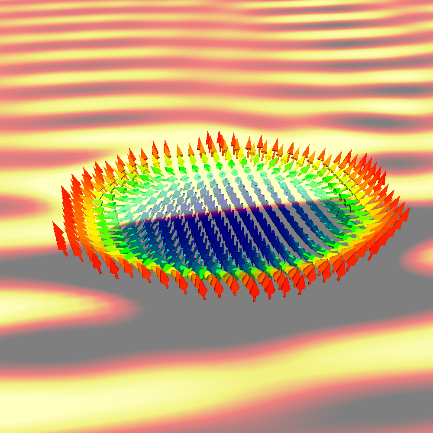Researchers reveal skyrmion physics driven by magnons in confined geometries

The magnetic skyrmion is a current hot topic in condensed matter physics, as it is a promising candidate as information carrier for building novel memory and logic computing devices. Reporting in the New Journal of Physics, a Chinese University of Hong Kong, Shenzhen (CUHKSZ) research group and their collaborators reveal the dynamics of skyrmions driven by magnons in confined geometries. They find that the position of a skyrmion can be efficiently manipulated by the magnon, and elucidate the principle of a magnon-driven skyrmion motion which might be of interest for practical applications.
The CUHKSZ Applied Spintronics Lab led by Prof. Yan Zhou and multi-institutional collaborators report in detail the motion and dynamics of an isolated skyrmion in a magnetic nanowire driven by magnonic momentum-transfer forces. The group's results show that the skyrmion trajectory is determined by an interplay of both forces due to the magnon and the device boundary in confined geometries. They find the skyrmion is attracted to the driving layer and is accelerated by the repulsive force due to the device boundary. The researchers also found that when a skyrmion is pushed into the driving layer by a strong driving magnon, the skyrmion velocity drops significantly, and eventually results in the destruction of the skyrmion. These new results provide a guide for future experimental studies on skyrmion motion in confined geometries driven by magnons.
"Previous studies suggested the skyrmion moves towards the magnon source due to magnon-skyrmion scattering, but we noticed that when the skyrmion is close to the device edge, it shows different dynamic behaviours, which are governed by both the driving force and the repulsive potential arising from the edge," said CUHKSZ researcher Xichao Zhang, the first author of the study.
"Skyrmion physics is complicated in confined geometries due to the presence of skyrmion-edge interactions. We considered two setups where magnons are excited either longitudinal or transverse to the nanotrack edge. We find that the longitudinal driving is less efficient partly due to the damping of the magnon," said Jing Xia, another author of the study. Ms. Xia is a Ph.D. student of the School of Science and Engineering and is a member of the group headed by Prof. Yan Zhou.
"The schemes of magnon-driven skyrmion motions could offer energy-efficient means of transmitting information in skyrmion-based racetrack memory and circuitry, which could pave the way for next-generation skyrmionic devices applications," said Yan Zhou, associate professor at the School of Science and Engineering and the director of the CUHKSZ Applied Spintronics Lab.
More information: Xichao Zhang, Jan Müller, Jing Xia, Markus Garst, Xiaoxi Liu, and Yan Zhou, Motion of skyrmions in nanowires driven by magnonic momentum-transfer forces, New Journal of Physics 19, 065001 (2017). DOI: 10.1088/1367-2630/aa6b70
Journal information: New Journal of Physics
Provided by The Chinese University of Hong Kong, Shenzhen




















